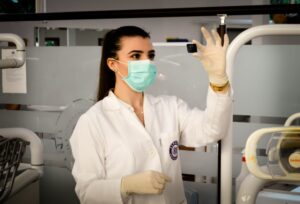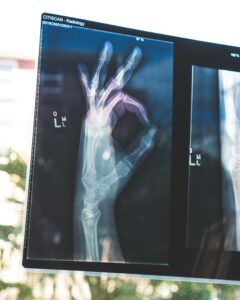1. Automated sorting and routing of packages in warehouses and distribution centers
In warehouses and distribution facilities, automated sorting and routing of packages are a procedure that uses computer vision technology to sort and route items based on their destination. This system scans and reads package labels using cameras and image recognition algorithms, and then uses that data to sort and direct the products to the right area. This can decrease the requirement for physical labor while also significantly improving the efficiency and accuracy of package handling.
The delivery can be rerouted to the appropriate place if the computer vision system detects any mistakes or damage to the package. Better inventory management and shipment tracking are also made possible by the system’s ability to track the packages in real time.
2. Vehicle and cargo monitoring for security and efficiency
The technique of applying artificial intelligence (AI) algorithms to track the movement and health of vehicles and cargo is known as vehicle and cargo monitoring for security and efficiency. This system tracks cars and cargo as they travel through logistics centers and along transportation routes using cameras and image recognition algorithms.
This can be helpful for a number of things, including making sure that cargo is loaded and emptied properly, spotting potential security risks, and following the flow of items in real-time. Any suspect activity near the goods and vehicles, such as someone trying to tamper with the cargo or someone breaking into the vehicle without authorization, can be detected using computer vision. This can aid in reducing the risk of theft, fraud, and other security lapses.
3. Inspection of goods for quality control
Before goods are distributed to clients, they are inspected for quality control using vision-based capabilities to look for flaws or other problems. This technology scans products and compares them to pre-established standards to make sure they comply with the essential quality requirements. It does this using cameras and image recognition algorithms.
Electronics, food, medical equipment, and a variety of other products can all be examined using computer vision. The system can check that items are correctly manufactured and that all required components are present, as well as flaws like scratches, dents, or missing parts.
The system can also be used to keep an eye on the production process and spot any problems that might occur.
4. Automated inventory management
Automatic inventory control Automating the tracking and administration of inventory in a warehouse or distribution center involves incorporating machine vision technologies. By scanning and reading product labels using cameras and image recognition software, this system automatically updates inventory levels in real-time.
The computer vision system can also monitor how items are moved about the warehouse, providing a more precise and current picture of inventory levels. This can increase overall warehouse efficiency and help avoid stockouts and overstocking.
The technology is also capable of identifying differences between the physical inventory and the inventory records and notifying warehouse management of any mistakes or inconsistencies.
5. Automated loading and unloading of cargo
The process of automatically loading and unloading cargo from vehicles and storage containers involves the use of computer vision technologies. This innovation loads and unloads the goods precisely using robotic arms or other automation equipment after using cameras and image recognition algorithms to recognize and identify the cargo.
Any faults or discrepancies during loading and unloading, such as mismatched cargo or improperly loaded containers, can be found using the computer vision system. This can increase the overall effectiveness and safety of the loading and unloading operation as well as lower the danger of cargo damage.
6. Obstacle detection for autonomous vehicles and drones
The technique of employing computer vision technology to find and identify barriers in the surroundings so that autonomous vehicles and drones can navigate safely is known as obstacle detection. This system scans the area and recognizes items including buildings, trees, pedestrians, and other vehicles using cameras and image recognition algorithms.
The optimal route for the drone or autonomous vehicle to take is then determined by the system using this data. The vehicle or drone’s path can be adjusted in response to any unexpected or unusual impediments, such as dropped objects or construction machinery, using the computer vision system. This can lessen the chance of collisions and increase the safety and dependability of autonomous vehicles and drones.
7. Reading and tracking shipping labels and barcodes
Using computer vision technology to scan and read the data on shipping labels and barcodes is the process of reading and tracking shipping labels and barcodes. The barcode or QR code on the shipping label is read by this technology using cameras and image recognition algorithms to extract the necessary data, including the destination, the tracking number, and other specifics.
The movement of items across the logistics chain may then be tracked using this information, which can also be used to automatically sort and route packages in a warehouse or distribution center.
The system may provide real-time visibility into the location and status of products by scanning and tracking shipping labels and barcodes, which can significantly increase the efficiency and accuracy of package handling and delivery.
8. Detection of package damage or tampering
The method of employing computer vision technology to automatically spot any damage or tampering to parcels while they are in transit is known as the detection of package damage or tampering. This device scans and inspects packages for any indications of damage, such as tears, dents, or punctures, as well as for any indications of manipulation, such as broken seals or missing labels. It does this using cameras and image recognition algorithms. The computer vision system can also be utilized to find any further irregularities on the package, like changes in shape or weight, that might point to damage or tampering.
The technology may instantly notify logistics staff of any difficulties by automatically identifying package damage or tampering, enabling them to take appropriate action to rectify the issue and ensure that the shipment is delivered intact.
9. Real-time monitoring of traffic and road conditions
The technique of employing computer vision technologies to track and assess traffic and road conditions in real time is known as real-time monitoring. This technology detects and tracks vehicles using cameras, radar, and other sensors. Image recognition algorithms then evaluate the data to estimate traffic and road conditions. In order to create real-time traffic maps and detect bottlenecks and other traffic problems, computer vision technology can be utilized to follow the movement of vehicles on the road.
In order to increase the effectiveness of logistical operations and lessen traffic congestion on the roads, this can give logistics managers and transportation authorities useful information. Road conditions, such as potholes and traffic, can also be detected using computer vision.
10. Predictive maintenance for logistics equipment
The technique of employing computer vision technology to forecast when maintenance or repairs are required for logistics equipment, such as trucks, forklifts, and other vehicles and machinery, is known as predictive maintenance. This device analyses the apparatus and finds any symptoms of wear and tear, including cracks, leaks, or other damage, using cameras and image recognition algorithms.
The computer vision system can also be used to track the functioning of the machinery, including how long it has been running, how fast it is moving, and how much damage the tires, brakes, and other parts have endured. The technology can forecast when maintenance or repairs are required and notify logistics managers to schedule maintenance by evaluating this data.
11. Facial recognition for secure access to warehouses and other logistics facilities
The concept of implementing video processing techniques to confirm the identity of people who are trying to enter a warehouse or other logistics facility is known as facial recognition for safe entry to warehouses and other logistics facilities. This device scans a person’s face and compares it to a pre-existing database of approved people using cameras and image recognition algorithms.
The mechanism allows entry to the facility if a match is made. By enhancing security and preventing unwanted access to logistics facilities, facial recognition technology also makes it possible for authorized people to check in more quickly and easily. Access control systems and security cameras can be combined with the system to create a more complete and secure security system.
12. Measurement of package dimensions for optimized packing and shipping
The process of correctly measuring package dimensions for efficient packing and shipment involves the use of computer vision technology. This is done in order to streamline the packing and shipping process. This technology scans packages and calculates their dimensions, such as length, breadth, and height, using cameras and image recognition algorithms.
The technology may make sure that items are packed and sent in the most time- and money-efficient manner feasible by measuring package measurements. It can be used, for instance, to figure out the right size and kind of shipping container for a certain product or the right manner to arrange packages in a truck or container for safe and effective delivery.
13. Augmented reality for training and guidance of warehouse workers
The technique of employing computer vision technology along with augmented reality (AR) to provide training and guidance to warehouse workers is known as augmented reality for training and guiding. Using AR displays like smart glasses or mobile devices, this technology scans the environment using cameras and image recognition algorithms to give workers real-time information and direction.
For instance, the system can be used to give employees up-to-the-minute information on product locations and proper handling techniques. It can also be used to give workers step-by-step directions for finishing jobs, as well as visual signals and directions to help them move around the warehouse and locate particular items or equipment.
14. Automatic classification and recognition of different types of cargo
The practise of employing computer vision technology to automatically recognise and classify various categories of cargo, such as various sorts of items or commodities, is known as automatic classification and recognition of diverse types of cargo. This technology scans and analyses the cargo using cameras and image recognition algorithms, and then uses the results to automatically classify and identify the cargo according to pre-established standards.
For instance, the system can be used to automatically recognise and categorize various product types, such as electronics, clothing, or food, and then arrange them in the appropriate order. This can decrease the need for manual labor and considerably increase the accuracy and efficiency of warehousing and logistics operations. The computer vision system can be utilized to spot any mistakes as well.
15. Automatic detection and tracking of vehicles and cargo in ports and harbors
The method of employing computer vision technology to automatically detect and track the movement of vehicles and cargo at ports and harbors is known as automatic detection and tracking. In order to scan the environment, find and identify the cars and goods, and then use that information to track their movement in real time, this system uses cameras and image recognition algorithms. The system can be used to monitor the motion of trucks, cargo ships, and other vehicles as well as the loading and unloading of cargo containers. This can considerably increase the effectiveness and precision of cargo handling operations by giving real-time visibility into the location and status of vehicles and cargo in the port or harbor. use of computer vision
16. Automatic detection of traffic congestion and bottlenecks in logistics networks
The technique of employing computer vision technology to automatically detect and identify locations of traffic congestion and bottlenecks in logistics networks is known as automatic detection of traffic congestion and bottlenecks. This system scans the logistics network with cameras and image recognition algorithms to find locations where traffic is moving slowly or not at all.
The system can be used to track and examine traffic patterns at distribution centers, warehouses, and on roads and highways. The system can give logistics managers and transportation authorities useful information on where to focus their efforts to increase the effectiveness of logistical operations by identifying congestion and bottlenecks in real-time. The usage of computer vision technologies can also be utilized to identify potential problems.
17. Automatic identification of driver fatigue and distraction
The method of automatically detecting and identifying indicators of driver fatigue and attention while operating a vehicle involves the use of computer vision technologies. In order to identify indicators of exhaustion or distraction, this system analyses the driver’s body language, eye movements, and facial expressions using cameras and image recognition algorithms.
The system, for instance, may identify indicators of distraction, such as glancing away from the road or using a mobile device, or signs of exhaustion, such as drooping eyelids or a nodding head. As soon as the system notices these warning indicators, it can notify the driver to take a break or redirect their attention, or in rare circumstances, it can even automatically slow down or stop the car to avoid an accident.
18. Automatic detection of traffic violations in logistics vehicles
The procedure of leveraging machine-learning software to automatically detect and identify traffic offenses committed by logistics vehicles is known as the automatic detection of traffic violations in logistics vehicles. This system analyses video footage of moving vehicles and utilizes image recognition algorithms to find any offenses, like speeding, running red lights, or unlawful lane changes.
When a violation occurs, the system can provide real-time notifications to transportation authorities or logistics management and can be used to monitor the movement of commercial trucks, buses, and other logistical vehicles. This can be used to identify and correct any concerns with driver conduct as well as aid to increase the safety of logistical operations. The system can also be utilized to find any problems.
19. Automatic monitoring of environmental conditions in logistics facilities
The technique of employing computer vision technology to automatically monitor and measure the environmental conditions in logistics facilities, such as warehouses and distribution centers, is known as automatic monitoring of environmental conditions in logistics facilities. This technology collects information on variables including temperature, humidity, light, and air quality using cameras, sensors, and image recognition algorithms.
The device may be used to monitor conditions in real-time and notify logistics management if any problems are found, such as excessive temperatures or levels of humidity that could harm items. The system can also be used to track any environmental changes over time, such as variations in temperature or humidity levels, which could point to problems with the facility’s heating or cooling systems.
20. Automatic detection of hazards and safety risks in logistics operations.
The advance of deploying deep-learning algorithms to automatically detect and identify potential dangers and safety risks in logistical operations, such as those carried out in warehouses, distribution facilities, and on the road. This device scans the environment for potential dangers including spills, barriers, or other safety threats using cameras, sensors, and image recognition algorithms.
For instance, the technology can be used to spot spills or other dangers on a warehouse floor and notify logistics staff so they can respond appropriately to clean up the spill and avoid accidents. The system can also be used to identify any equipment problems, such as broken or malfunctioning machinery, that could endanger people’s safety.









